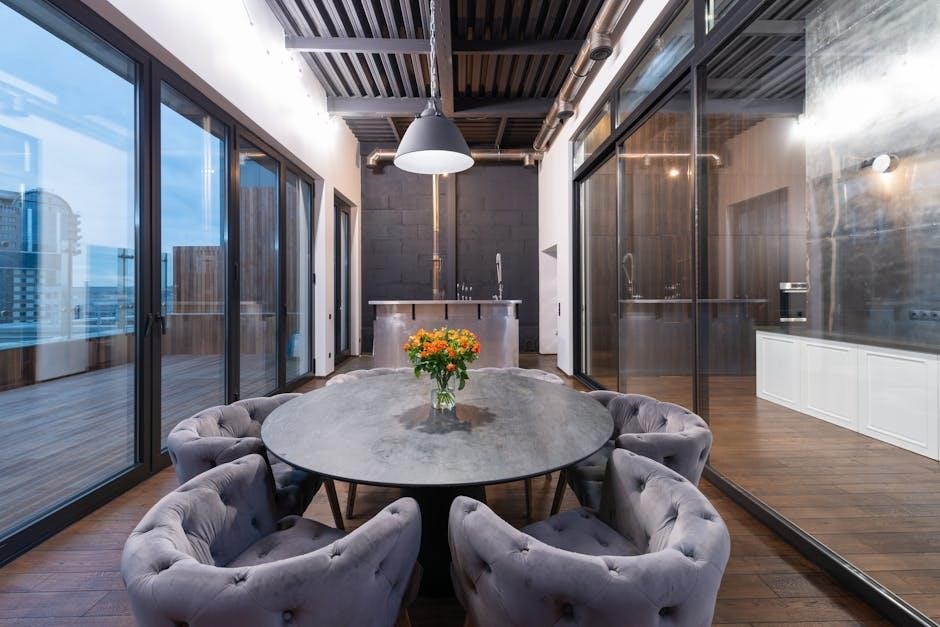Understanding wedge loft is crucial for optimizing short-game performance. This guide explores types of wedges, their loft ranges, and how loft impacts trajectory, distance, and control, helping golfers make informed decisions.
1.1 Understanding the Importance of Wedge Loft in Golf
Wedge loft plays a critical role in determining trajectory, distance, and spin, making it essential for precise short-game performance. The loft angle directly impacts how high and far the ball flies, influencing club selection for various shots. Proper loft ensures consistent gapping between clubs, avoiding distance overlaps or gaps. For skilled players, understanding loft is key to executing high, soft shots for better control around the greens. It also affects bounce and grind effectiveness, adapting to different playing conditions. Accurate loft selection enhances accuracy and consistency, making it a foundational element in a golfer’s arsenal. By mastering wedge loft, players can improve their ability to navigate challenging lies and pin positions effectively.
1.2 Overview of Different Types of Wedges
Golfers utilize four primary types of wedges: Pitching, Gap, Sand, and Lob wedges. Each serves a specific purpose, with distinct loft ranges. Pitching wedges (44-49 degrees) are used for full shots and longer approaches. Gap wedges (49-54 degrees) bridge the distance gap between pitching and sand wedges. Sand wedges (54-58 degrees) excel in bunker shots and high arcs, while Lob wedges (58 degrees and higher) deliver the highest trajectories for precise, soft landings. Understanding these types and their roles is essential for selecting the right club in various situations, ensuring versatility and adaptability on the course. Proper wedge selection enhances short-game performance, allowing players to tackle diverse challenges with confidence.

Types of Wedges and Their Loft Ranges

Golf wedges include Pitching (44-49°), Gap (49-54°), Sand (54-58°), and Lob (58°+) wedges. Each loft range serves specific purposes, from full shots to high arcs, enhancing short-game versatility.
2.1 Pitching Wedge (44-49 Degrees)
The Pitching Wedge (PW) typically ranges from 44 to 49 degrees of loft, making it the most versatile wedge in a golfer’s bag. Designed for full shots from 100 to 130 yards, it bridges the gap between the irons and the higher-lofted wedges. Modern Pitching Wedges often feature slightly lower lofts to maximize distance, especially in game-improvement sets. This club is ideal for approach shots to the green and can also be used for chipping from the fringe or fairway. Its moderate loft allows for a lower trajectory compared to higher-lofted wedges, providing precision and control. Golfers often use the PW as a foundation for their wedge setup, ensuring proper gapping with the next club in their bag. The right loft angle depends on individual swing characteristics and the desired ball flight.
2.2 Gap Wedge (49-54 Degrees)
The Gap Wedge, often referred to as the Approach Wedge (AW), fills the distance gap between the Pitching Wedge and the Sand Wedge. Typically ranging from 49 to 54 degrees of loft, it is designed for shots requiring a higher trajectory than a Pitching Wedge but less than a Sand Wedge. This club excels at distances of 80 to 110 yards, making it ideal for approach shots to the green or for navigating bunkers and other obstacles. The moderate loft allows for precise control and a softer landing, which is crucial for scoring opportunities. Golfers often carry a Gap Wedge to ensure consistent distance gapping in their wedge setup, preventing any significant yardage overlaps or gaps between clubs.
2.3 Sand Wedge (54-58 Degrees)
The Sand Wedge is a versatile club designed for high-arcing shots, typically used from 80 to 110 yards. With a loft range of 54 to 58 degrees, it excels at escaping bunkers and producing soft landings on the green. The higher loft angle generates more spin, allowing the ball to stop quickly, which is ideal for approach shots and recovery situations. Its wider sole and higher bounce design help navigate sandy lies and thick rough. Golfers often rely on the Sand Wedge for precision and control in challenging lies, making it a critical component of a well-rounded short game. Proper use of the Sand Wedge can significantly improve scoring opportunities by addressing shots that require elevation and accuracy.
2.4 Lob Wedge (58 Degrees and Higher)
The Lob Wedge, with its loft of 58 degrees or higher, is designed for extremely high-arcing shots, making it ideal for tight lies and situations requiring maximum elevation. This wedge is perfect for shots needing to clear obstacles or land softly on the green from short distances, typically within 20 to 40 yards. Its steep angle generates significant spin, allowing for precise control and minimal roll. Often used in flop shots, the Lob Wedge is a favorite among skilled players for its ability to navigate challenging lies and deliver the ball quickly to the target. Proper technique is essential to maximize its effectiveness, as it demands a precise swing to avoid thin or heavy contact.

How Loft Affects Wedge Performance
Loft significantly impacts a wedge’s trajectory, height, and spin. Higher loft angles produce steeper launch angles and more spin, while lower lofts result in flatter, longer shots.
3.1 Trajectory and Height
The loft of a wedge directly influences the trajectory and height of the ball. Higher loft angles, such as those in lob wedges (58 degrees and above), produce steeper launch angles, resulting in higher trajectories. This allows for maximum elevation, making it easier to clear obstacles like bunkers or tall grass. Conversely, lower loft wedges, like pitching wedges (44-49 degrees), generate flatter trajectories, which are better suited for longer approach shots. Understanding how loft affects trajectory is crucial for selecting the right wedge to achieve the desired ball flight. Proper loft selection ensures the ball reaches the optimal height for the situation, whether it’s a soft landing on the green or navigating challenging lies.

3.2 Distance and Accuracy

Wedge loft significantly impacts both distance and accuracy in golf. Lower loft wedges, such as pitching wedges (44-49 degrees), generally produce longer shots with flatter trajectories, making them ideal for full swings from the fairway. Higher loft wedges, like lob wedges (58 degrees and above), prioritize accuracy over distance, delivering shorter, higher shots with softer landings. Proper gapping between wedges ensures consistent distance control, while the right loft selection minimizes yardage overlaps. Accuracy is further enhanced by matching the loft to the situation, such as using a sand wedge (54-58 degrees) for bunker shots or a gap wedge (49-54 degrees) for mid-range approaches. Understanding how loft affects distance and accuracy is key to improving short-game performance and scoring.
3.3 Spin and Control
Wedge loft plays a critical role in generating spin and control, especially in short-game situations. Higher loft wedges, such as lob wedges (58 degrees and above), produce greater spin rates, allowing for softer landings and quicker stops on the green. Lower loft wedges, like pitching wedges (44-49 degrees), generate less spin, resulting in more roll. The right loft selection enables precise control over the ball’s trajectory and spin, which is essential for navigating various lies and pin positions. Additionally, bounce and grind options on wedges further enhance spin and control, particularly in different turf conditions. Properly fitting wedges to a player’s swing and technique maximizes spin performance, ensuring better consistency and accuracy around the greens.
The Importance of Gapping in Your Wedge Setup
Proper gapping ensures consistent distance coverage between wedges, preventing yardage overlaps or gaps. This setup is vital for accuracy and confidence in various short-game situations.
4.1 Ensuring Proper Distance Gaps Between Clubs
Proper distance gaps between wedges are essential for consistent performance. A general rule is to maintain 4-6 degree loft differences, translating to 10-15 yard distance intervals. This ensures each club has a specific role, avoiding overlaps and gaps. For example, a pitching wedge at 46 degrees, gap wedge at 50 degrees, sand wedge at 54 degrees, and lob wedge at 58 degrees creates balanced coverage. This setup allows golfers to address various shots with precision, knowing the exact distance each club delivers. Proper gapping enhances strategy and execution, making it easier to select the right club for any situation.
4.2 Avoiding Overlapping or Missing Distances
Avoiding overlapping or missing distances in your wedge setup is vital for consistency. Overlapping occurs when two wedges cover the same yardage, leading to confusion and inconsistent shots. Missing distances, on the other hand, create gaps where no club is suitable for a specific yardage. To prevent this, ensure each wedge has a distinct role with clear distance separation. For example, a gap wedge at 50 degrees, sand wedge at 54 degrees, and lob wedge at 58 degrees provides balanced coverage. This setup eliminates overlaps and ensures every distance within your short game is accounted for. Proper gapping allows for precise shot selection and execution, making it easier to navigate various on-course situations effectively.

Factors to Consider When Choosing Wedge Loft
When selecting wedge loft, consider bounce and grind options, shaft length, and material. Personal swing characteristics, such as attack angle and speed, also play a crucial role.
5.1 Bounce and Grind Options

Bounce and grind are critical factors in wedge selection, influencing how the club interacts with the turf. Bounce refers to the angle between the clubface and the sole, affecting forgiveness and versatility. A higher bounce is ideal for players with a steep swing, while lower bounce suits those with a shallow swing. Grind options, such as the popular Vokey D and F grinds, determine how the club behaves in various lies. The right combination enhances control and consistency, allowing for precise shots from sand, rough, or tight lies. Proper bounce and grind ensure optimal performance, tailored to individual swing mechanics and playing conditions.
5.2 Shaft Length and Material
Shaft length and material play a significant role in wedge performance, impacting feel, accuracy, and consistency. Standard shaft lengths for wedges typically range from 34 to 36 inches, with shorter shafts offering better control for precise shots. Materials vary between steel and graphite, each providing distinct benefits. Steel shafts are durable, offer a firmer feel, and are preferred by skilled players for feedback. Graphite shafts are lighter, reducing vibration and suits players seeking distance and forgiveness. The right combination of length and material aligns with individual swing characteristics, ensuring optimal performance. Proper fitting is essential to maximize the benefits of these design elements and enhance overall wedge play.
5.3 Personal Swing Characteristics
Personal swing characteristics, such as tempo, speed, and attack angle, significantly influence wedge loft selection. Players with faster swing speeds may prefer slightly lower loft angles for better distance control, while slower swings benefit from higher lofts for increased height. The attack angle also plays a role, as steep angles require more loft to prevent digging, while shallow angles may need less. Additionally, a player’s ability to generate spin affects loft choices, with higher lofts enhancing spin control. Proper club fitting is essential to align wedge loft with individual swing dynamics, ensuring optimal performance and consistency. Understanding these factors helps golfers tailor their wedge setup for improved accuracy and scoring opportunities;

Tips for Using Wedges Effectively

Selecting the right wedge for the situation is key. Adjust your technique based on loft angle, swing speed, and attack angle to optimize trajectory and spin for precise shots.
6.1 Selecting the Right Wedge for the Situation
Selecting the right wedge for the situation is vital for consistent short-game performance. Understanding the loft and distance gaps between your wedges helps you choose the appropriate club for the shot. For full shots, a pitching wedge (44-49°) is ideal for longer distances, while a gap wedge (49-54°) bridges the distance gap to the green. A sand wedge (54-58°) excels in bunkers and high arcs, and a lob wedge (58°+) is perfect for tight pins and high elevation needs. Consider the lie, pin position, and required trajectory when making your selection. Adjusting your swing technique to match the wedge’s loft ensures precise control and consistent results.
6.2 Adjusting Technique for Different Loft Angles
Adjusting your technique for different loft angles is essential for maximizing wedge performance. For lower-lofted wedges like the pitching wedge (44-49°), focus on a shallower swing path and fuller contact. As loft increases, such as with the gap wedge (49-54°), slightly open the clubface and use a steeper angle of attack. Sand wedges (54-58°) require a more vertical swing to escape bunkers effectively. Lob wedges (58°+) demand precise control, with a softer grip pressure and a higher arc to clear obstacles. Practice varying your stance, ball position, and swing tempo to adapt to each wedge’s loft. This ensures consistent results and enhances your ability to handle diverse short-game scenarios with confidence and precision.
In conclusion, mastering wedge loft is essential for elevating your short-game performance. By understanding the role of loft in trajectory, distance, and spin, golfers can select the right club for every situation. Proper gapping ensures seamless distance transitions, while technique adjustments optimize results for each loft angle. Whether it’s a pitching wedge for full shots or a lob wedge for high arcs, tailoring your approach to the club’s design enhances control and accuracy. Remember, consistency and practice are key to unlocking the full potential of your wedges. With the right setup and technique, you’ll be better equipped to tackle challenges on the course and achieve lower scores with confidence.